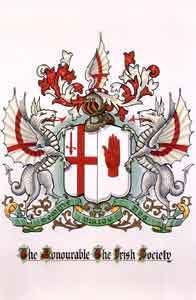 | ||
The Society of the Governor and Assistants, London, of the New Plantation in Ulster, within the Realm of Ireland, commonly called the Irish Society or The Honourable The Irish Society, is a consortium of livery companies of the City of London set up in 1613 to colonise County Londonderry during the Plantation of Ulster. It was incorporated by royal charter of James I and consists of "six and twenty honest and discreet citizens of London" nominated by the livery companies. In its first decades it rebuilt the city of Derry and town of Coleraine, and for centuries it owned property and fishing rights near both towns. Some of the society's profits were used to develop the economy and infrastructure of the area, while some was returned to the London investors, and some used for charitable work.
The society remains in existence as a "relatively small grant-giving charitable body". Its educational grants are funded by its remaining property, including the Walls of Derry, a tourist attraction and heritage site, and fisheries on the River Bann. It is based in London, with a "Representative" resident in County Londonderry. It remains closely linked with the City of London: its Governor is traditionally a former Lord Mayor of London, and members of the Court of Aldermen and Court of Common Council of the Corporation of London constitute members of the Court of The Honourable The Irish Society.
History
The Nine Years' War between Gaelic Irish chiefs and the Dublin Castle administration of the Kingdom of Ireland ended in Gaelic defeat 1603, and the Flight of the Earls in 1607 left northwest Ulster open to colonisation. In planning the plantation of Ulster, King James I set out to defend against a future attack from within or without. In his survey, he found that the town of Derry could become either a great asset as a control over the River Foyle and Lough Swilly, or it could become an inviting back door if the people of the area were against him. He pressured the guilds of the City of London to fund the resettlement of the area, including the building of a new walled city, and the result was the creation of the society. The Virginia Company of London had been created similarly in 1606 to colonise North America.
The city of Derry was renamed Londonderry in recognition of the London origin of the Irish Society. County Coleraine was enlarged and renamed County Londonderry after its new county town. The rural area of the county was subdivided between the Great Twelve livery companies, while the towns and environs of Londonderry and Coleraine were retained by the Irish Society. The society was sequestrated in 1630, fined for non-performance in 1635, and suppressed in 1637; it was revived by Oliver Cromwell in 1650 and again after the Restoration by Londonderry's 1662 royal charter. A dispute with the Church of Ireland Bishop of Derry over fishing rights was appealed from the Irish House of Lords to the English House of Lords, in a controversial move later sanctioned by the Declaratory Act of 1719. A private act of the Parliament of Ireland was also passed in 1704 to resolve the dispute.
In 1832 the Skinners' Company brought a lawsuit against the Irish Society, arguing that the society held its property in trust for the livery companies, and that its profits should be redistributed to them. In 1845, a House of Lords ruling was that the society's grant was made for "public purposes", and since then its profits have been used entirely for charitable ends. Until the Municipal Corporations (Ireland) Act 1840, the society had influence on the municipal corporations of Derry and Coleraine, with right of appointment of some officials and right of veto over some classes of decision. The society also had some disputes with the corporations over ownership and development of property.
During the 17th and 18th centuries four of the twelve livery companies sold their estates, the Irish Society requiring in each case a bond of indemnity. The leases to middlemen granted by the other companies expired at various times during the nineteenth century, after which the companies "enormously increased the rental". While the companies' rural estates were sold to tenants under the Irish Land Acts after 1870, the Irish Society's urban property was exempt from the acts. An 1889 House of Commons select committee report stated:
From the evidence of these witnesses it appeared that there was no complaint as to the manner in which the Irish Society had performed its duties; and, with regard to the different City Companies, it was admitted that till recently they had acted with liberality. They had built churches and schools throughout their respective districts, and had subscribed with great liberality to the local charities. The complaint was that this liberality on the part of some of the Companies has greatly diminished, that some subscriptions have been entirely withdrawn, and others considerably diminished, and that some of the Livery Companies who had formerly given subscriptions to various local charities had sold their lands recently without making provision for the continuance of these subscriptions.The Society financed the building of Derry's Guildhall. Work started in 1887 and it was opened in July 1890, having cost £19,000. By the 21st century the Irish Society's property portfolio was "much reduced".
